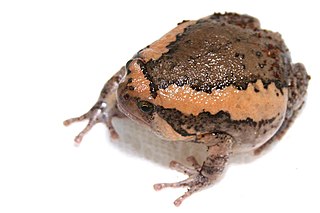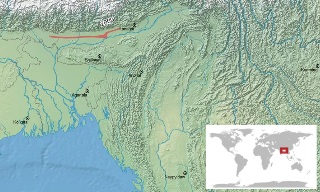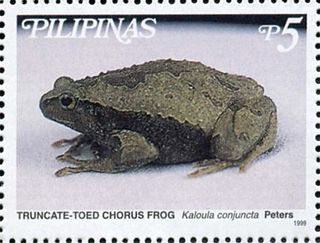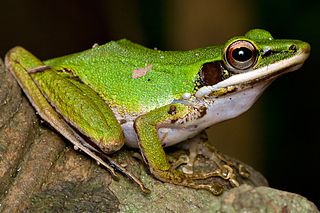
A true toad is any member of the family Bufonidae, in the order Anura. This is the only family of anurans in which all members are known as toads, although some may be called frogs. The bufonids now comprise more than 35 genera, Bufo being the best known.

The banded bullfrog is a species of frog in the narrow-mouthed frog family Microhylidae. Native to Southeast Asia, it is also known as the Asian painted frog, digging frog, Malaysian bullfrog, common Asian frog, and painted balloon frog. In the pet trade, it is sometimes called the chubby frog. Adults measure 5.4 to 7.5 cm and have a dark brown back with stripes that vary from copper-brown to salmon pink.

Kalophrynus is a genus of microhylid frogs. It is the only genus in the subfamily Kalophryninae. The species in this genus are found in southern China, in Southeast Asia to Java and Philippines, and in Assam, India.

Kaloula is a genus of microhylid frogs found in southern and eastern Asia. They are sometimes known as the Asian narrowmouth toads.

Microhyla ornata, commonly known as the ornate narrow-mouthed frog, ornate narrow-mouthed toad, or ornamented pygmy frog, is a species of microhylid frog found in South Asia. This amphibian is distributed in Kashmir, Nepal, peninsular India and the Andaman and Nicobar Islands, Sri Lanka, and Bangladesh. It was previously considered to be the same species as Microhyla fissipes; therefore, the aforementioned common names can refer to either species.

Fejervarya limnocharis is a species of frog found in South East Asia and parts of Indochina. It is known under many common names, including Boie's wart frog, rice field frog, and Asian grass frog. Molecular studies of the species complex suggest that there may be multiple species involved.

Kaloula assamensis, also known as Assamese balloon frog or Assam narrow-mouth toad, is a species of narrow-mouthed frogs found in Assam, Arunachal Pradesh, and West Bengal in northeastern India.

Microhyla berdmorei is a species of narrow-mouthed frog found in eastern India, Bangladesh, southernmost China (Yunnan), Mainland Southeast Asia as well as Borneo and Sumatra. Frogs from Bangladesh probably represent an unnamed species.

Microhyla chakrapanii is a species of frog in the family Microhylidae, the narrow-mouthed frogs. It is endemic to the Andaman Islands. It is also known as the Mayabunder rice frog, Chakrapani's narrow-mouthed frog, and bilateral banded frog. Although morphology suggests association with the Microhyla achatina group, molecular data places it in the Microhyla fissipes group, with Microhyla mymensinghensis as its closest relative.

Hose's frog is a true frog species with a wide range in Southeast Asia. This species was named after zoologist Charles Hose.

Ansonia leptopus is a species of toad in the family Bufonidae. It is known from a few lowland localities in Borneo, Sumatra (Indonesia), and Peninsular Malaysia; it is reported as common in lowland Malaysian Borneo. Its presence in Peninsular Malaysia is uncertain. Its common names are brown slender toad, Matang stream toad, and cricket-voiced toad.

Pelophryne misera, the black flathead toad or Kinabalu dwarf toad, is a species of toad in the family Bufonidae. It is endemic to northwestern Borneo and known from Sabah and Sarawak (Malaysia), although its distribution is likely to be broader and might extend to Kalimantan (Indonesia). It was first described from specimens collected from Mount Kinabalu.

The Philippine narrowmouth toad or the truncate-toed chorus frog is a species of frog in the family Microhylidae. It is endemic to the Philippines. Its natural habitats are subtropical or tropical dry forests, subtropical or tropical moist lowland forests, subtropical or tropical moist shrubland, subtropical or tropical seasonally wet or flooded lowland grassland, rivers, intermittent rivers, freshwater lakes, intermittent freshwater lakes, freshwater marshes, intermittent freshwater marshes, arable land, pastureland, plantations, rural gardens, heavily degraded former forest, water storage areas, ponds, irrigated land, and seasonally flooded agricultural land. It is threatened by habitat loss.

The Kalinga narrowmouth toad is a species of frog in the family Microhylidae. It is endemic to the Philippines. Its natural habitats are subtropical or tropical moist lowland forests, subtropical or tropical moist montane forests, arable land, pastureland, and plantations. It is threatened by habitat loss.
Kaloula walteri is a species of frog in the family Microhylidae. It is endemic to the Philippines, where it is found in the mountains of southeastern Luzon Island and Polillo Island. The specific name walteri honors Walter C. Brown, an American herpetologist. Common name Walter's narrow-mouthed frog has been proposed for it. Kaloula walteri is most closely related to Kaloula rigida.

Polypedates leucomystax is a species in the shrub frog family Rhacophoridae. It is known under numerous common names, including common tree frog, four-lined tree frog, golden tree frog or striped tree frog. Many past authors have united it with the common Indian tree frog in P. maculatus, but today they are generally considered distinct species. In its native range, it is also called "white-lipped tree frog", but this name is otherwise applied to a species of true tree frogs.

Polypedates macrotis, commonly known as the dark-eared treefrog, sometimes also Bongao tree frog, Bongao bubble-nest frog, Baram whipping frog, or brown-striped tree frog, is a species of frog in the family Rhacophoridae. It is found in the central peninsular Thailand, Sumatra, Borneo, and Sulu Archipelago as well as a range of other Philippine islands.

Chalcorana raniceps, also known as the copper-cheeked frog, white-lipped frog, or Peters' Malaysian frog, is a species of "true frog" in the family Ranidae. It is endemic to Borneo, including Brunei Darussalam, Kalimantan (Indonesia), and Sarawak (Malaysia), although it is likely to occur more widely. Previously mixed with Chalcorana chalconota and believed to have much wider distribution, its range was delimited to Borneo in the revision of "Rana chalconota" complex by Robert Inger and colleagues in 2009.

Kaloula latidisca is a species of frogs in the family Microhylidae. It is endemic to Kedah, Malaysia. Its presence in southern Thailand is uncertain. It is most similar to Kaloula baleata and Kaloula indochinensis.



















